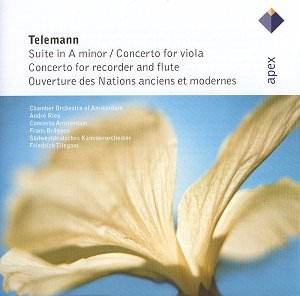This is a highly enjoyable disc, full of joyfully tuneful music
which is continually full of surprises. The degree of inventiveness and
imagination which Telemann shows in these four examples of his creativity
never ceases to amaze. He produced a vast amount of music in his sixty
years as a composer, peaking as he did in the two years 1705-1706 when
in the employ of Count Erdmann II of Promnitz. The Count had been on a
‘grand tour’ and returned enthused by the arts he had seen and heard while
in France, whereupon he encouraged his Hofkapellmeister to compose according
to the overtures and dance suites of Lully. The formula of this French
‘ouverture’ became fairly predictable, a slow opening in a dotted rhythm,
a more contrapuntal quasi-fugal section, and a varied reference back to
the rhythm of the opening in the third section. Thereupon the ouverture
gathered to itself a collection of following dances to form a suite consisting
of such movements as Passepieds, Réjouissances, Polonaises, Airs,
Menuets and so on. Telemann wrote an incredible 134 suites which we know
of, the bulk of them pre-1721 when he arrived in Hamburg. Not only did
he imbue the French and Italian styles, but also the Polish (hence the
Polonaises) with its trenchant rhythms and colourful melodies. The suite
depicting the various nations, old and new, is full of graceful, wittily
charming music, some of it tongue in cheek such as stolidly ponderous
Germanic, a poised Swedish sarabande, and a rather swaggering gavotte
for the Danes. Each nation is given a ‘before and after’ approach with
the old followed immediately by the new, and generally slower followed
by faster in terms of tempo.
The two concertos are in turn fascinatingly original
(that for recorder, flute and strings) and, for the viola, gloriously
mellow sounding. It proved an interesting experiment to juxtapose the
two wind instruments in the same concerto, like the suite of nations,
the recorder can be seen as the old whilst the more modern transverse
flute, the instrument we know today, is the new. The lovely second movement
appears accompanied by guitars with all the strings playing pizzicato,
the finale fizzes along at breakneck speed. Again to underscore his
originality (as Bach did with his sixth Brandenburg Concerto
with its absence of violins making the violas the highest of the string
instruments) it was an inspired decision to write for the viola, written
when he was in Frankfurt sometime between 1712 and 1721. Simple in format,
it is a highly tuneful work which paints the tone colours of the viola
in all its glory.
The names of the recorder player Frans Brüggen
and the harpsichordist Gustav Leonhardt are very familiar and these
are early recordings some thirty years old, since when they have both
spread their wings in the field of authenticity and original instruments.
Even though they may not yet have arrived at their musicological conclusions,
the playing here is exemplary, particularly Brüggen ‘s extraordinary
dexterity and fluency. Ably supported by the various Dutch or German
orchestras this is an excellent compilation of music by an under-exposed
composer, who, judging by this music, was a lot more significant than
perhaps we have thought hitherto.
Christopher Fifield
|
